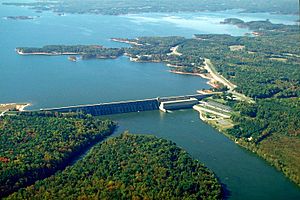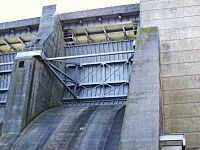John H. Kerr Dam facts for kids
Quick facts for kids John H. Kerr Dam |
|
|---|---|

John H. Kerr Dam
|
|
| Location | Mecklenburg County, Virginia, USA |
| Coordinates | 36°35′53″N 78°17′55″W / 36.59806°N 78.29861°W |
| Construction began | 1947 |
| Opening date | 1953 |
| Operator(s) | U.S. Army Corps of Engineers |
| Dam and spillways | |
| Type of dam | Concrete gravity |
| Impounds | Roanoke River |
| Height | 144 ft (44 m) |
| Length | 2,785 ft (849 m) |
| Reservoir | |
| Creates | Kerr Lake |
| Surface area | 50,000 acres (20,000 ha) |
| Power station | |
| Turbines | 7 Francis units |
| Installed capacity | 227 MW |
| Annual generation | 426.749 GWh |
The John H. Kerr Dam is a huge concrete dam built across the Roanoke River in Virginia. It created a large body of water called Kerr Lake. The U.S. Army Corps of Engineers built this dam between 1947 and 1953.
The main reasons for building the dam were to control floods and to produce electricity from water power. But it also helps with wildlife, forest protection, and offers fun activities for people. The John H. Kerr Dam makes over 426 GWh of electricity every year. It has also stopped more than $385 million in flood damage since it was finished. The dam is named after John H. Kerr, a Congressman from North Carolina. He was very important in getting the dam approved.
Building the Big Dam
Plans for the John H. Kerr Dam were approved by the U.S. Congress in 1944. However, construction didn't start until 1947. The spot was chosen because the ground had strong granite rock. This rock could support a very large concrete dam.
When construction first began, the project was called Buggs Island Lake. This name came from an island downstream, which was named after an early pioneer named Samuel Bugg. Later, in 1951, Congress decided to rename the project the John H. Kerr Dam.
The John H. Kerr Dam Project included the dam itself, a powerhouse (where electricity is made), and a switchyard (where electricity is sent out). The dam was built in 53 large sections, which are like giant concrete blocks called monoliths. Workers also built a special tunnel inside the dam. This tunnel helped them fill any small gaps between the dam and its foundation with concrete.
The dam has a spillway with 22 large tainter gates. These gates open to let extra water flow over the dam during floods. At the very bottom of the dam, there are 6 smaller sluice gates. These gates help control the normal flow of water downstream. The entire dam project was completed and opened in 1953.
How the Dam Makes Electricity
The hydro-power plant inside the John H. Kerr Dam is very powerful. It has 7 large machines called Francis units. These units can produce a total of 227 megawatts (MW) of electricity.
Six of the large generators in the power plant each make 32 MW of electricity. There's also one smaller unit that produces 12 MW. This hydro-power plant is very efficient, working at about 83% efficiency.
The electricity produced here is sold to different companies. About 58% of the power goes to Dominion Energy. The other 42% is sold to Progress Energy. The Southeastern Power Administration helps manage and distribute all this power. About half of the electricity is sent to special government customers, like rural electric cooperatives. These cooperatives then provide power to homes and farms in the countryside.
Other links
- Kerr Lake
- Kerr Lake State Recreation Area


